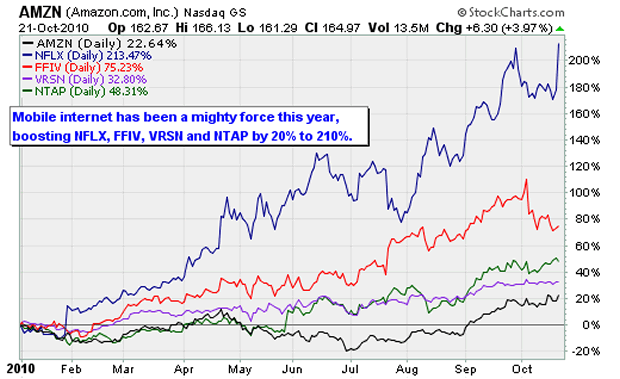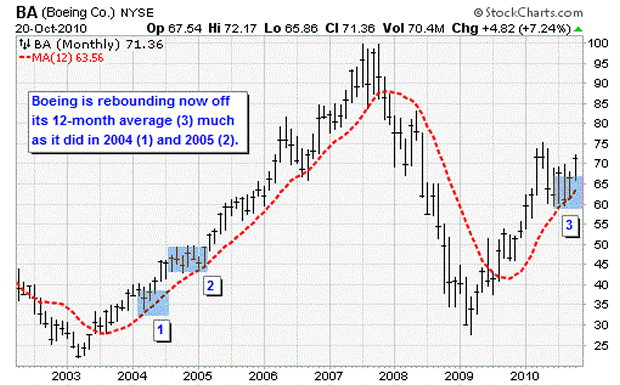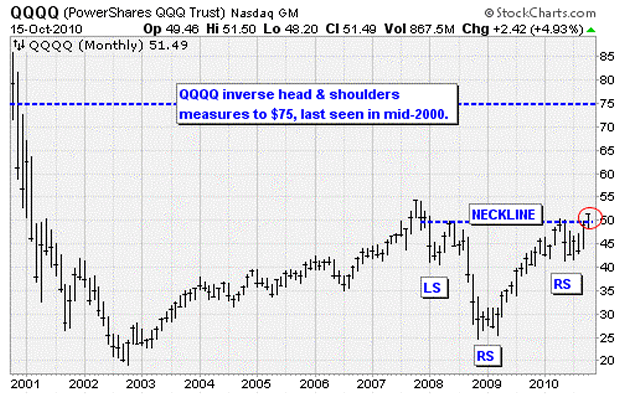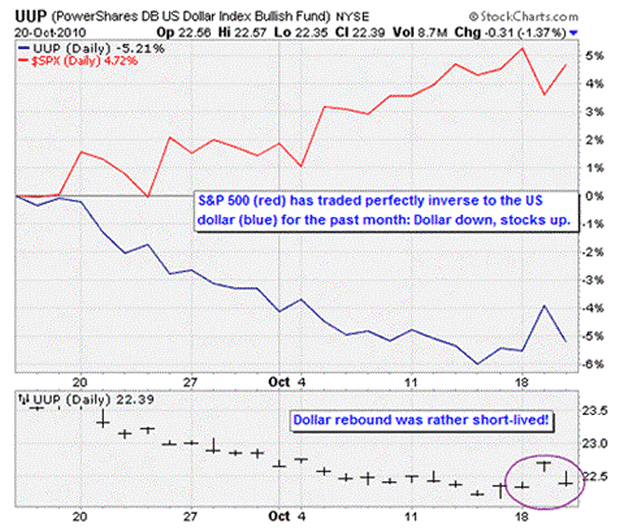How Bernanke Will Pump Stocks Higher Into Year End, Sectors that Will Soar
Stock-Markets / Stock Markets 2010 Oct 25, 2010 - 05:40 AM GMTBy: Money_Morning
 Jon D. Markman writes: While many investors have solid reasons to remain concerned about the broader economic picture, there are some market sectors roaring forward that no one can afford to miss - and they will continue to provide profit opportunities thanks to the work of U.S. Federal Reserve Chairman Ben Bernanke.
Jon D. Markman writes: While many investors have solid reasons to remain concerned about the broader economic picture, there are some market sectors roaring forward that no one can afford to miss - and they will continue to provide profit opportunities thanks to the work of U.S. Federal Reserve Chairman Ben Bernanke.
 Stocks rattled around in 295-point range of the Dow Jones Industrial Average over the past five days like pebbles in a maraca, but ended quietly -- a fraction above flat. The big-cap indexes have now posted six of their past seven closes within half a percent, hemmed in by some sort of spooky gravitational pull.
Stocks rattled around in 295-point range of the Dow Jones Industrial Average over the past five days like pebbles in a maraca, but ended quietly -- a fraction above flat. The big-cap indexes have now posted six of their past seven closes within half a percent, hemmed in by some sort of spooky gravitational pull.
Earnings came in quite a bit better than expected for most major companies, as the cheap dollar has helped overseas sales for Caterpillar Inc. (NYSE: CAT) and McDonald's Corp (NYSE: MCD). Over in the exciting web content space, Netflix Inc. (Nasdaq: NFLX) wowed the crowd with outstanding third-quarter results, logging a sales increase of 31.0% and adding 1.9 million net new customers. That's a lot of new buyers in an economic environment that is supposed to be so terrible that the Federal Reserve thinks unprecedented medicine is required.
Think about it: Netflix total subscribers were up 52.0% year over year. Apple Inc. (Nasdaq: AAPL) on Tuesday said earnings from its iPhones and iPads were up 91.0%. Amazon.com Inc. (Nasdaq: AMZN) reported a great quarter tonight. Google Inc.'s (Nasdaq: GOOG) earnings were way up. Are you getting the picture?

This just goes to show the power of the mobile Internet, as that is where consumers and companies are putting their money. It is a blazing neon sign that says mobile content and networking and advertising and retailing are combining to push the online digital revolution past overdrive into hyper-speed.
For investors looking for higher than average returns, this is the industry of the year, and probably will be one of the best places to invest in the first half of the decade. Those of you who are old enough to remember the 1990s will recall that companies in the thick of that decade's hottest trends -- enterprise networking, data storage, and the mass-marketing of PCs -- rose up to 50,000%. Yes, that is a lot of zeros in front of the percent sign. The stocks were EMC Corp. (NYSE: EMC), Dell Inc. (Nasdaq: DELL), Cisco Systems Inc. (Nasdaq: CSCO) and the original version of AOL Inc. (NYSE: AOL).

Also helping the mood on Wednesday were solid earnings reports from American industrial goliaths The Boeing Co. (NYSE: BA) and United Technologies Corp. (NYSE: UTX); their results were emblematic of robust earnings from overseas customers. All those newly wealthy countries in Southeast Asian and Africa want to zoom close to developed-world status by buying new commercial aircraft, and BA and UTX will oblige.
The emerging world is extremely under-served by jets, so all the major U.S. and European aerospace firms likely have a long, strong cycle ahead. I'll have more about the stocks in this industry soon.
On the economics side of the day, weekly initial jobless claims fell by 23,000 to 452,000 but last week's figure was revised sharply higher. The trend is still lower but by such a small amount it can barely be viewed by a microscope. This continues to be a huge problem for consumer confidence, but on the other hand, we can see in the results of companies like Caterpillar that the bottom line is benefiting from lower labor expenses. Companies are getting more productivity and income out of fewer workers, and they like that just fine -- and see no reason to heavily hire yet.
Another reason they see no reason to go on a hiring spree: Demand for goods has not gone crazy yet. We can see that in the weak reading from the Philadelphia Fed's manufacturing index, which was published on Thursday. The index gained but it has only reversed a small portion of what was lost in the summer. Without wishing to bore you with all the numbers, measures such as shipments and output are just not consistent with a robust recovery, and we could find manufacturing slipping very close to recession territory early next year.
When you put the weak manufacturing numbers together with the anemic hiring levels, there's nothing in the data seen this week that would prevent the Fed from announcing a second round of quantitative easing at its November meeting.
Yet I want to be very clear: While the overall economy is weak, certain areas -- mobile phones, mobile Internet, apparel, airlines and restaurants -- are performing fairly well. It seems as if consumers have decided to spend money on a narrowing number of items, with connections to their social networks near the top of the list.
Bottom line: As investors we have the luxury of worrying about the broad economy while at the same time concentrating our investments in the parts that are working well. For now those areas are emerging markets, mobile networking, high-quality dividend-paying stocks, and high-yield bonds.
Driving Forces For Upside
The positive driving forces at this phase of the cycle now are the Federal Reserve, which wants to infuse the U.S. financial system with enough money to combat disinflation and encourage hiring; companies flush with bond money that want to buy out competitors; the falling dollar, which drives up the price of commodities like copper and hard currencies like gold; strong economic growth in emerging markets more focused than ever on domestic demand; and innovative companies like Apple, Google and Chipotle Mexican Grill (NYSE: CMG), which excel at creating cool products on which worried consumers want to spend their scarce capital.
The negative driving forces of the cycle are the decline in housing prices and demand, which have deprived the economy of the construction jobs it needs; the decline in CEO confidence, which is leading them to restrain hiring; the foreclosure mess, which is causing investors to expect a new round of large mortgage write-down at banks; widening budget crises in U.S. states and cities; and fears that the federal government has inadequate fiscal and monetary tools to push the very slow U.S. economy toward its goals.
When you weigh the positives against the negatives, it's like a Shakespearean play -- the tragedy Hamlet, perhaps. Lack of confidence, indecisiveness, rage and the urge for revenge are weighed against a serious discussion of a peaceful way forward that just might work. Somehow we rationally know that there must be a way out of the mess of debt and currency debasement, but our minds race ahead to a more perilous end. We all fear fast-forwarding to the conclusion of Act III and seeing the financial equivalent of Hamlet, Gertrude, Claudius and Laertes all dead from sword-fighting and poison.

The most important actor on this stage is the Federal Reserve, which has determined that its past efforts to stimulate the economy through cutting interest rates did not go far enough. Rather than deciding the effort didn't work because of an inherent flaw, it has decided to just do more of it. It's this expectation that has created the very positive inverse head-and-shoulders pattern in the Nasdaq 100 Trust (Nasdaq: QQQQ) that you see in the chart above.
And what else would you expect? As I have said before, when all you have is a hammer everything looks like a nail. The Fed is the only force in the government that is run autocratically; it has committees but the decision making is accomplished by consensus. And that consensus has always centered around what members believe their chairman wants. Since Chairman Ben Bernanke looks at data coming in from manufacturers and inflation measurers that is not to his liking, he has determined that he needs to hammer the economy with every nail in his toolbox. And so it shall be done.
I don't mean to get all literary and cynical on you here. I'm just noting that the decision to move forward with renewed quantitative easing is essentially being made by a single figure based on a single economic theory that he has personally developed over his career. He believes it is the right thing to do, and he has the means to temporarily persuade most other people that it is the right thing to do. But we won't really know with any scientific certainty that it's the right thing to do until it is executed and some time goes by.
How long will it take until we know if the effort is tragedy or comedy? My expectation is that the markets are willing to believe it will work at least through the end of the year, with occasional rest periods and much more volatility than we have seen until now. But by the time a month has gone by in the new year, my sources in the hedge fund community say that there had better be tangible results -- or investors will reverse all the positive effects seen to that date by selling stocks and commodities in preparation for a new leg down.
This not quite as simple a chronology as it may sound at first blush because part of the genius of Bernanke's approach is to try to get the markets to do what fiscal and monetary stimulus so far have failed to accomplish.
I am told, again by sources in the institutional trading community, that the chairman's aim at this point is to improve the economy through this chain of events: a) make the investment community think that he's going to flood the zone with cheap money; b) have them buy stocks on the belief that his methods will work; c) increase consumer confidence via the rising market such that ...; d) the country experiences a fantastic holiday shopping season, such that ...; e) retailers are forced to restock their inventories by ordering more product, so that ...; f) companies rebuild their inventories by hiring more workers.
I realize that sounds faintly convoluted -- almost a Rube Goldberg approach to economics. But I would not doubt for a moment that this is the plan, at root. Though of course he would never describe it in this pedestrian way.
Bernanke has been consistent with this concept since the time well before he was chairman and was just a minor player at the Fed, in addition to his day job running the economics department at Princeton. He does not wish to be the Fed chairman who was in office during a depression or deflation as long as he has the tools to fight.
We have seen that he is very imaginative -- creating new tools when old ones did not suffice. It's pretty clear to me now that he is even using this office to purchase Standard & Poor's 500 Index futures whenever a bad report on the economy is released to push sentiment toward the favorable end of the dial. This is manipulation of the greatest degree, but since it is being used in favor of the markets you are not hearing any complaints.
So as we go forward, keep in mind that Bernanke will keep stimulating until he achieves his goal of inflation above 2.0%. It is currently under 1.0%. That doesn't sound like a big difference, but it is -- and it will take a big, long effort to achieve the goal. And by the way, this is not the inflation number that we are used to seeing, which is tied to the price of things like energy and food. This is a monetary inflation figure as published by the Cleveland Fed, which estimates the inflation attributable to monetary policy only.
The bottom line for us at this point is the belief that this will occur and will be enough to keep a fire lit under stock prices both here and overseas. Of course there will be rough spots -- possibly including a retreat all the way back to the 1,130 breakout level of the S&P 500 -- but ultimately I think we can expect higher stocks into year-end unless a major crisis develops somewhere.

Let me just close by noting that the dollar called the shots again. After abruptly jumping higher on Tuesday, it turned around and tripped on Wednesday. I realize that the dollar is extremely oversold, but there is no reason for the buck to rise materially when it is U.S. government policy to debase it.
The dollar's renewed collapse keyed the stock rebound like a point guard in basketball. Remember this chain: When the dollar rises, the euro falls, risk trades come off, commodities fall and emerging markets fall. When the dollar sinks, as it has for the past three months, the euro rises, risk trades go back on, commodities rise and emerging markets rise.
Week In Review
The past week was light on economics news. Here is a quick look at key changes, with a big hand from the analysts at Decision Economics and Econoday.
With 159 companies within the S&P 500 reported, earnings are tracking at +48.0% year-on-year. Revenues grew 6.0% year-on-year, surpassing the growth seen this time last quarter. Profit margins continue to improve and now stand at 11.5%. Prior to the start of earnings season, the majority of companies issuing guidance fell short of analyst estimates (at roughly 4:1 ratio); however, so far, 78% of companies have reported upside surprises over market consensus. The current track of operating earnings for the S&P 500 stands at $21.10, a blend of actual and estimates for all 500 companies. That is the recipe for a V-shaped recovery in profits.
Quick recap of economics news for the past week:
•Housing starts were flat at depressed levels in September, but the summer slide is behind us.
•Manufacturing production slid in September as the recovery slowed.
•Despite an surprise rate hike by China early this week, equity markets recovered on strong corporate earnings results. The S&P 500 rose 0.4% while the Dow remained flat for the week.
•The 10-year Treasury yield remained unchanged at 2.55%.
•The dollar gained 2.0% against the British pound sterling and 0.5% against the euro.
The Week Ahead
Homebuilders will look for signs of supply shrinking with existing home sales out on Monday and new home sales printing Wednesday. And retailers will look for improvement in consumer spirits with consumer confidence released Tuesday and sentiment at week end. But the market movers will likely be the manufacturing update with durable orders on Wednesday and a first look at third quarter GDP on Friday.
Monday: Report on existing home sales in September. Inventories are still quite bloated. Consensus: 4.30 million-unit rate.
Tuesday: The Conference Board will report Consumer Confidence Index. It fell last month and we're unlikely to see an improvement as jobs stay hard to get. Consensus forecast: 50.0.
Wednesday: Durable goods orders for September. They dipped in August but they're trending positive. Consensus: +1.6%. Also, new home sales for September. Expect it to remain anemic.
Consensus: 300,000 annual run rate.
Thursday: Initial jobless claims. They fell last week; expect marginal improvement again. Consensus: 455,000.
Friday: Estimate of GDP growth for the third quarter. Consensus: +2.0%.
[Editor's Note: Money Morning Contributing Writer Jon D. Markman has a unique view of both the world economy and the global financial markets. With uncertainty the watchword and volatility the norm in today's markets, low-risk/high-profit investments will be tougher than ever to find.
It will take a seasoned guide to uncover those opportunities.
Markman is that guide.
In the face of what's been the toughest market for investors since the Great Depression, it's time to sweep away the uncertainty and eradicate the worry. That's why investors subscribe to Markman's Strategic Advantage newsletter every week: He can see opportunity when other investors are blinded by worry.
Subscribe to Strategic Advantage and hire Markman to be your guide. For more information, please click here.]
Source : http://moneymorning.com/2010/10/25/bernanke-3/
Money Morning/The Money Map Report
©2010 Monument Street Publishing. All Rights Reserved. Protected by copyright laws of the United States and international treaties. Any reproduction, copying, or redistribution (electronic or otherwise, including on the world wide web), of content from this website, in whole or in part, is strictly prohibited without the express written permission of Monument Street Publishing. 105 West Monument Street, Baltimore MD 21201, Email: customerservice@moneymorning.com
Disclaimer: Nothing published by Money Morning should be considered personalized investment advice. Although our employees may answer your general customer service questions, they are not licensed under securities laws to address your particular investment situation. No communication by our employees to you should be deemed as personalized investent advice. We expressly forbid our writers from having a financial interest in any security recommended to our readers. All of our employees and agents must wait 24 hours after on-line publication, or 72 hours after the mailing of printed-only publication prior to following an initial recommendation. Any investments recommended by Money Morning should be made only after consulting with your investment advisor and only after reviewing the prospectus or financial statements of the company.
Money Morning Archive |
© 2005-2022 http://www.MarketOracle.co.uk - The Market Oracle is a FREE Daily Financial Markets Analysis & Forecasting online publication.



